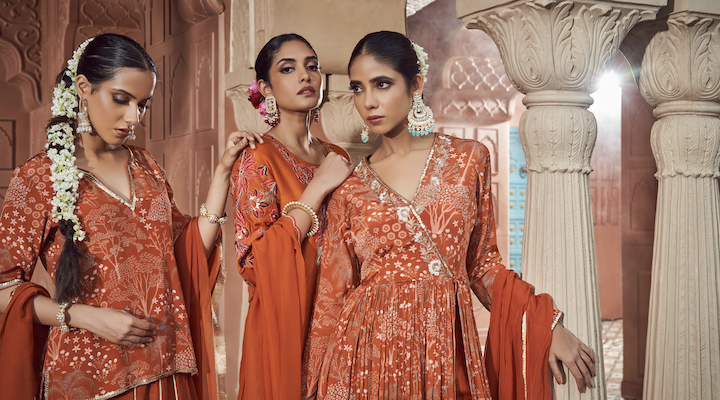Earlier this year, Knight Frank’s study ‘The Wealth Report 2024’ estimated that India will experience the biggest increase in the number of ultra-high-net-worth individuals of any country between 2023 and 2028. India’s increasing wealth has made the market more attractive and competitive than ever for both local and international luxury brands, underscoring its status as a key player in the global luxury landscape. In the past few years, fashion conglomerates, including Relia
Reliance Brands and Aditya Birla Fashion and Retail, have increased their investment in top Indian designers. These significant investments have fostered a thriving environment for artisanal talent and innovation, bringing India to the forefront of high fashion.
Luxury couture, as part of the sector, has also experienced a notable uptick.
State of the luxury
“The luxury couture market in India is experiencing a significant upsurge, driven by increasing disposable incomes, a growing affinity for luxury brands, and a flourishing wedding industry. Indian designers are gaining global recognition for their intricate craftsmanship and innovative designs, making India a hub for luxury couture,” Megha Pitti, founder of Indian couture brand Megha Pitti, told Inside Retail.
Euromonitor International estimated India’s luxury market to be one of the fastest-growing in the world, with a projected value of $8.5 billion last year from $2.5 billion from 2021.
Distinctive nature
Different to Western and other Asian markets, the Indian luxury couture sector is primarily focused on weddings, which is deeply tied to social status.
“Bridal couture overwhelmingly dominates the market, even smaller designers are seeing growth in this segment – they are insulated from economic shifts,” said Aashumi Mahajan, co-founder at The Luxe Maison. “Bridal wear is and will be the cornerstone of the luxury couture industry in India for a long time.”
However, she added the appetite for luxury couture, however, is still limited outside of weddings.
The sector is currently dominated by established luxury houses, including Sabyasachi, Manish Malhotra, Abu Jani and Sandeep and Tarun Tahiliani. The incorporation of traditional crafts and regional influences adds a unique dimension to the creations, setting Indian couture apart on the global stage.
“We are seeing a renewed appreciation for indigenous textiles like Paithani and Patola sarees,” Mahajan added. “This revival is also reflected in the market, where there is a growing willingness to invest in weaves and handlooms, recognising them in India’s deep-rooted traditions.”
Meanwhile, Pitti said Bollywood celebrities and cultural influencers also wield significant influence in shaping luxury couture trends in India.
“Their red carpet appearances and social media presence often set the tone for fashion trends and influence consumer preferences,” Pitti added.
Emphasising the impact of the country’s film industry, Mahajan said the powerful connection between Bollywood and fashion drives trends and shapes consumer behaviour in the luxury couture market, demonstrating how deeply cultural influencers impact the industry.
“Their outfits – whether from airport looks, Diwali parties, or red carpet events – become trendsetting, with their choices quickly followed by fans across India. The impact is so substantial that items worn by celebrities frequently sell out – no matter the price or brand popularity, and entrepreneurs in smaller cities rapidly create replicas to meet the demand,” she said.
Growth drivers
According to Mahajan, the rise of luxury couture in India in recent years can be attributed to the increase in the purchasing power of millennials and the overall increase in disposable income across various demographics in India, especially tier 2 cities. This has enabled a broader segment of the population to access and indulge in luxury couture, further propelling the market’s growth.
“Additionally, there’s been a noticeable shift in consumer behaviour with more people prioritising spending over savings – leading to a higher willingness to invest in luxury products,” she said.
“While a growing GDP generally boosts disposable income and increases demand for high-end fashion, and a strong Rupee can make luxury goods more affordable, these effects are not as pronounced as in Western markets. Currency fluctuations and economic conditions do affect pricing and consumer spending, but the overall impact on the luxury couture sector in India tends to be less dramatic compared to the West.”
Rising new retail concepts
In India, luxury purchases predominantly occur in brick-and-mortar stores, and several unique retail concepts are emerging to enhance the shopping experience.
“Luxury stores such as Anita Dongre’s flagship boutiques are creating immersive environments with personalised styling sessions and exclusive events to engage customers in a more interactive way. Hybrid retail models are also gaining traction, with brands like Manish Malhotra offering virtual consultations and online fittings to complement their physical store experiences,” Mahajan shared.
She added cultural collaborations are evident in collections such as Tarun Tahiliani’s work with traditional Indian artisans, which celebrates India’s rich heritage through limited-edition pieces. Additionally, luxury pop-up stores, like those hosted by the Indian Couture Week, provide temporary spaces that showcase exclusive collections and create buzz among fashion enthusiasts.
“These innovations reflect a shift towards more personalised, immersive, and culturally connected retail experiences in the Indian luxury couture market.”
Consultancy firm Bain & Co projected the country’s luxury market to reach between $85 billion and $90 billion in value by 2030.
Mahajan said there would be a sharp rise in homegrown luxury brands gaining momentum in India as well as international markets over the next decade thanks to their corporate investors.
“As the past continues to inspire contemporary fashion, India’s luxury couture industry is evolving into a vibrant fusion of heritage and modernity, where cultural legacy meets future innovation,” she concluded.

